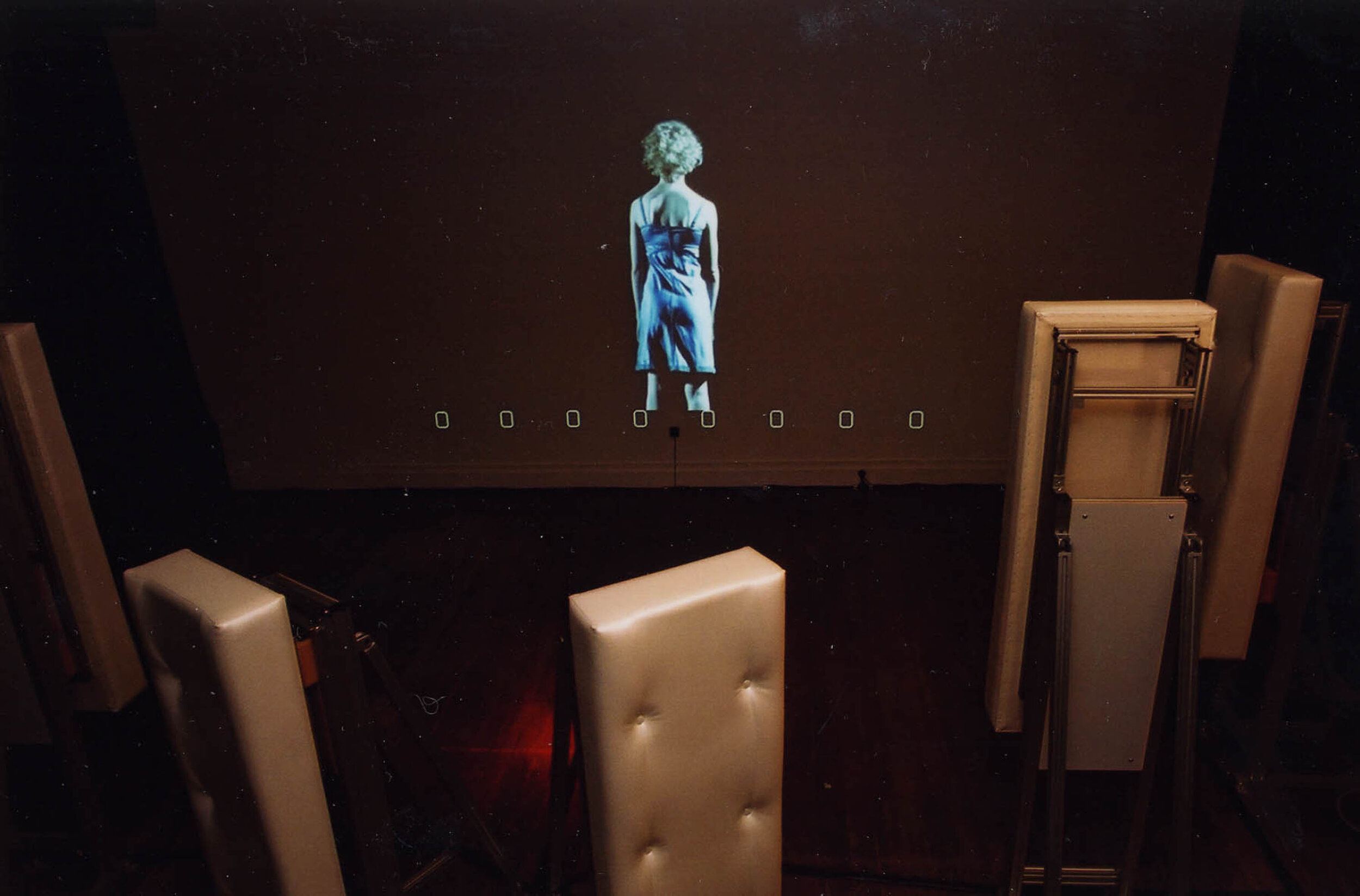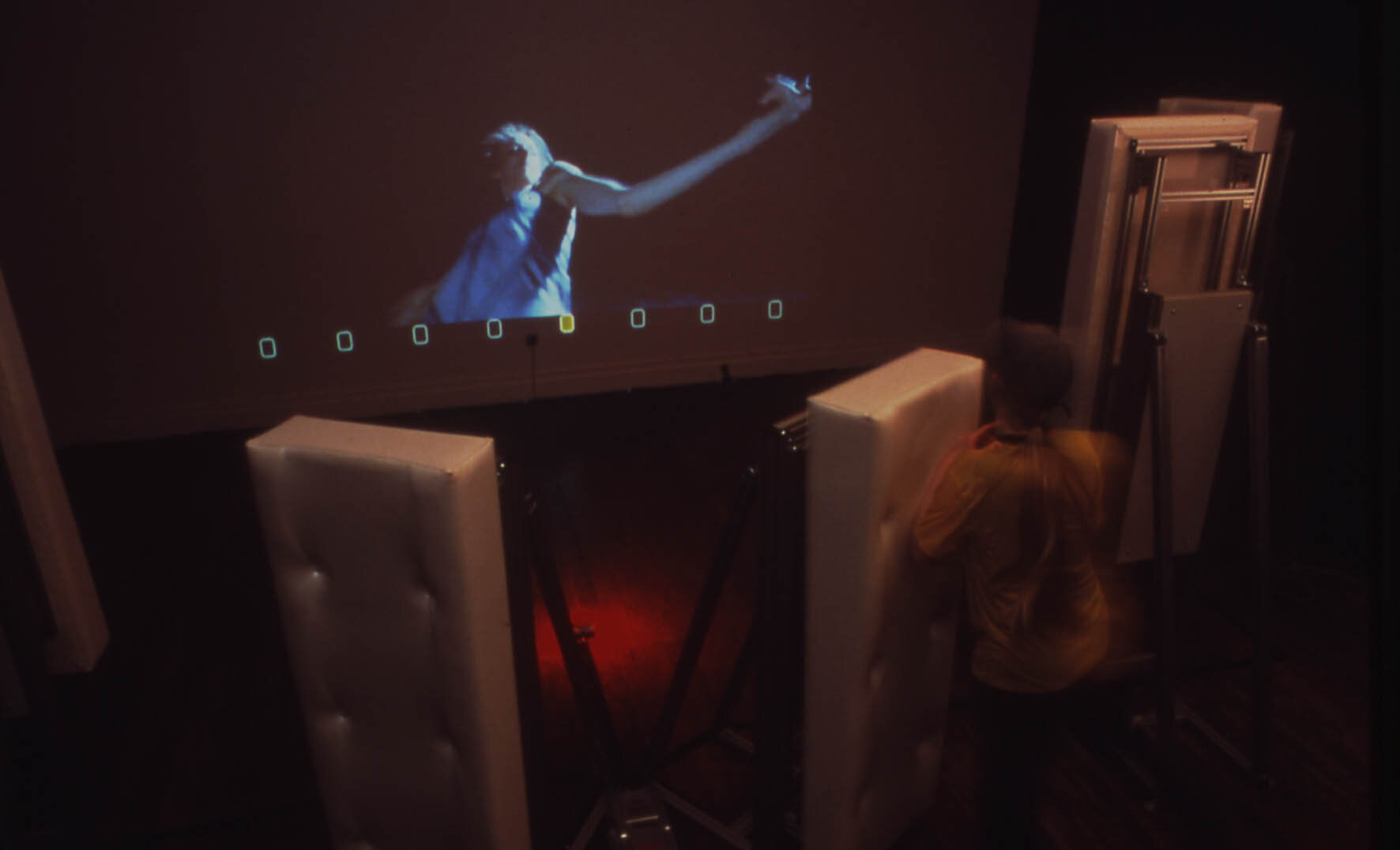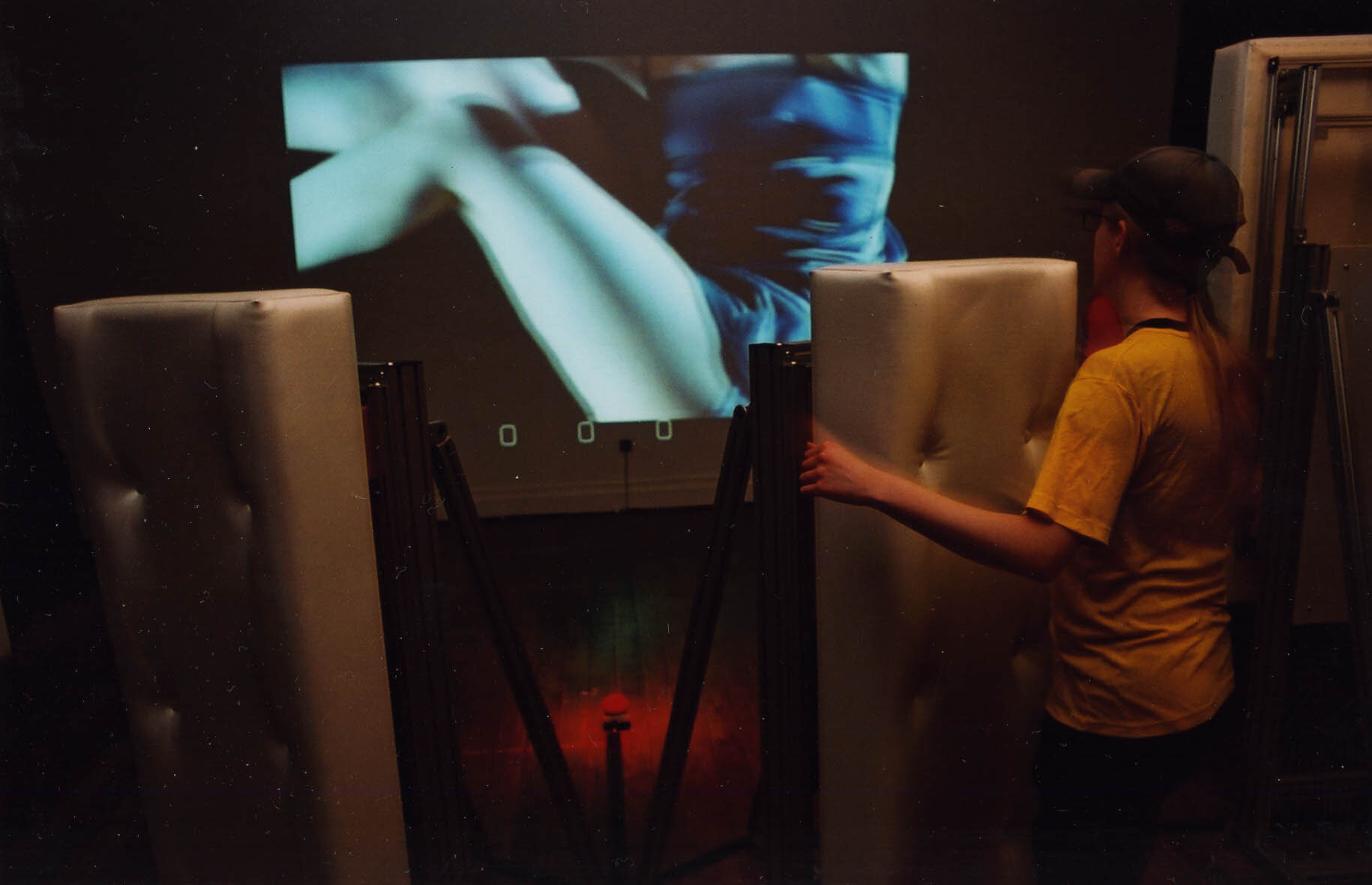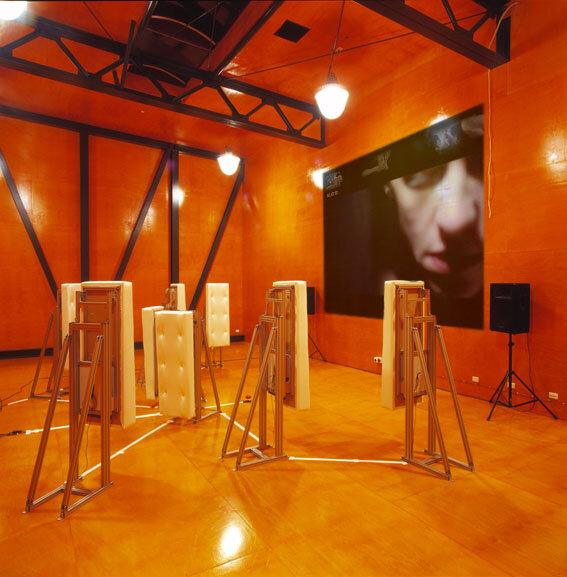Closer 2002
Closer was a screen-based dance installation. Completely interactive, it combined real-time video processing with eight floor-mounted sensor pads that responded to audience members using their bodies to modify the moves of an on-screen dancer.
Conceptually, the creation and the visualisation of the choreography came from the artists’ desire to allow themselves and the audience to get as close as possible to the performer. Dance is usually experienced from the passive distance of theatre seats. The audience sees little more than the shapes bodies make on stage, and this is primarily what the choreographer has to work with in constructing a dance work. The minute complexities of the body – the ripple and flex of the skin and muscles, the hair, the pores – often remain unseen in this traditional theatre context but are central to the choreographic palette of Closer. The body and motion of the dancer is expanded to completely fill the installation space with a ‘micro-choreography’ of subtle gestures, physical details and violent impacts.
As the audience played with Closer, they became aware of the reflective relationship they shared with the dancer and their interplay created a constantly changing audiovisual environment. The installation literally brought the audience closer to the work in every sense - closer to its creation, closer to the subtle details of its movement and closer to the body of its dancer.
Closer is a screen-based dance installation. Completely interactive, Closer combines real-time video processing with eight floor-mounted sensor pads that respond to audience members using their bodies to modify the moves of an on-screen dancer.
Conceptually, the creation and the visualisation of the choreography come from the artists’ desire to allow themselves and the audience to get as close as possible to the performer. Dance is usually experienced from the passive distance of theatre seats. The audience sees little more than the shapes bodies make on stage, and this is primarily what the choreographer has to work with in constructing a dance work. The minute complexities of the body – the ripple and flex of the skin and muscles, the hair, the pores – often remain unseen in the traditional theatre context but are central to the choreographic palette of Closer. The body and motion of the dancer is expanded to completely fill the installation space with a ‘micro-choreography’ of subtle gestures, physical details and violent impacts.
As the audience plays with Closer, they become aware of the reflective relationship they share with the dancer and their interplay creates a constantly changing audiovisual environment. The installation literally brings the audience closer to the work in every sense - closer to its creation, closer to the subtle details of its movement and closer to the body of its dancer.
The choreography in Closer is granular and, while carefully considered, it is constantly transformed and reconstructed by the audience. In a sense, Closer redefines the space as a choreographic instrument, which is played by its audience to create new works every time. Closer might also be thought of as an investigative tool, one that allows the audience to explore in more and more detail the structure and intricacies of the movement and the body of the dancer.
The audience’s interaction with the work, via large physical actions, is very different from the usual ‘mouse and keyboard’ interface that usually defines multimedia installations. As they activate the large wall pads, their bodies are pushed into a kind of physicality that is especially unusual in a traditional gallery context. They literally impact on the work.
Choreography Gideon Obarzanek
Interactive & Visual Design Peter Hennessey
Cinematography Cordelia Beresford
Audio Landscape Darrin Verhagen
Performer Nicole Johnston
Artistic Director Gideon Obarzanek
Executive Producer Vivia Hickman
Exhibition Dates
Australian Centre for the Moving Image
6 December 2002 — 27 March 2003
Touring History
2002 Sydney
2003 Perth
“Closer generated some sweat and a bit of heat from those who were technologically under-whelmed or grumpy at the very idea of tossing a woman around on a screen. It’s a bit like walking into a gym that specialised in Pilates but in which the reformers are vertical – big leather quilted pads torso-high on stands and facing various directions dominated by a screen where a dancer (Nicole Johnston) waits to be activated by you pushing or hurling yourself against the pads. Your actions also triggers sounds, so you compose and choreograph at once.” REAL TIME.
2002 Interview with Gideon Obarzanek
What is Closer?
Closer is an installation that allows people to direct and influence a projection of a moving body, a dancing body and body parts. I became interested a while ago with the idea of a documenting a single body in movement with extreme close ups and observations of joints and skin moving at variable speeds that were not possible to do in live performance, the area I normally work in. I originally wanted to create an architectural space that gave the person walking through it a sense of looking out at a single body that is located in fragments or parts all around them.
In speaking about this idea with Peter Hennessey, he suggested that we could introduce an interactive element where people walking through the room could trigger movements and sequences as they were watching an on screen dancer. They would therefore become very sensitised to their own movement during this process. We went through a whole series of different ideas of what, how that could possibly work and we basically ended up with a current model that we have now.
What were the working methods used to produce Closer?
The working methods for me were to initially to sit down with Peter and talk about the actual structure of how the space would operate, the content of the piece, and what people could actually trigger in the installation. Nicole Johnston and I then went into a studio, I think for about two weeks, and worked on a number of movement phrases. We worked with a small video camera during this time and devised the daggy dancer sequence, which is a menu of bad dance phrases that people could put together. The frenetic section is based on Nicole doing quite a lot of collision impacts against a wall.
The interface between the audience and the installation was conceived around the pads, and having Nicole reciprocate that kind of collision in the sequence, was important to the installation. The floor phrase really came up in the studio while we were working. The idea that Nicole becomes free of the ground, and of gravity, seems to work really well. So Nicole and I worked together for a couple weeks and Peter came in on a regular basis. Cordelia Beresford, the cinematographer, came on the last few days before the final film shoot. So when we came to the film shoot, which took two days, she pretty much ran the show. Peter was present to advise us about the editing, and how it would be structured in the computer. We shot the whole series of movement phrases on super 16 film. From then on pretty much, Peter had the bulk of the work to do, which consisted of coding and editing the piece. We did discuss a lot of the music with Darren Verhagen prior to and after the shooting but most of the music started to come together once we had already edited some of the rough ideas for the scenes.
What are your influences with regard to dance practice with this particular project?
Certainly my practice has been in live work and that’s the area I am most familiar with. I have relied on Peter a lot for this particular project. For me, it has been about getting closer to the body and being able to be more sensitive to choreography that is happening on a smaller scale, basically magnifying it.
What was the overall effect I was aiming to achieve with the interactive image base component of closer?
I guess there are two major features in the work. One is the content and the other is based on how one views the on screen body. Oh, and another objective for Closer is focused on the interactive relationship that the punters will have with the installation itself. While there is a lot of technology being used to make this happen, it is important for me that people won’t be aware of it. What I do find fascinating is the blur between the on screen dancer and the way in which participants will control, direct and influence the piece. For instance, people may realise that pad 1 may reverse the movement, pad 2 may zoom in, pad 3 may bring the image into focus and pad 4 may change the point of view and so on, and so very quickly they become engaged in constructing, making and choosing how they want to see the dancing body.
The work has areas that are a lot of fun, like the daggy dancer sequence where you can make these bad dance steps and put them together and you can speed them up and slow them down and its got this pretty funky bad taste music to it. But then it has much more. It’s interesting, to know whether there will be co-operation or competition between people using the installation. I hope to see some people go into this work and come out sweating because of the action that is required of them to participate with the piece.
How does the endoscopic footage fit and connect with the imagery and the choreography of the digital dancer?
A proximity sensor only triggers the endoscopic footage if somebody walks towards the screen. There are no instructions and there is no information telling you that this will occur, so you will not see this sequence unless you walk to the screen itself. If you are interested in what is going on with the screen, you will be able to walk a certain distance towards the dancer, but beyond that distance the body will turn around and stop and look at you. If you walk closer, the dancer will move further away. If you walk even closer, she’ll open her mouth and then you will watch a sequence in which you are taken on a journey through her body to finish out and on the other side. You can only get so close and then you are shunted through to be behind.
How does the installation represent the dancing?
Well, the installation represents the dancing as movement and action that can be analysed, reconfigured and guided. The viewer’s relationship to the dancer is more analytical in this work, so it becomes more like a study that you have control over rather than lets say, a traditional dance performance where you are sitting fairly passively and the dancer and/ or the choreographer have very much made the decisions of what they wish to show you and how they want to show it to you. Now of course in this work, there are still major decisions being made by the choreographer and the people making it, but it does give you a menu of choices in regards to how you wish to view and compose it.
I must say though, watching people interact with the work during our testing period you begin to wonder who controls who? Audiences wishing to direct the work on screen are making some very fascinating choreography in the room as they are in turn also guided by the conditions set by the installation.
How does this project fit in with Chunky Move’s direction?
Well, this project sits very much in the kind of direction where I think Chunky Move is heading. We have a strong interest in how the audience view dance. I have done works like ‘Live Acts’ at Revolver (a nightclub in Melbourne) mixing performance, music and visual artists over four months. That seemed to work pretty well and I was interested in audiences attending this project, who would not normally go to theatre, but might appreciate this type of work.
I also have an interest in what can audiences can see and experience of the body in action and also making decisions about what they want to see and in doing so effect the work. Here we see the body very close in a work that has no beginning or end, it only comes to life when the viewer’s body willingly exerts itself, and when the viewer stops the work also ceases to continue.
What am you currently working on?
I want to work on a Revolve, which will focus on a revolving stage. Hopefully I will be starting that in 2003. I want to cut the revolve into a number of pie slices and have interior sets and have these sort of interior domestic scenes happening, a little bit like a soap opera. However, this work would not necessarily be a soap opera but it will use the same convention of time passing by the revolving of these things and so that's something I want to work towards.
I would like to work on a solo actually, which is kind of unusual for me because I very rarely perform in my own works. I haven't performed for quite a few years. I kind of sometimes jump in and do bits and pieces. It would only be a short piece, of half an hour. It would certainly have a lot of text in it because that is something that's kind of interesting for me at the moment.
The other thing since making Closer that I didn't expect, is that it has become very beautiful and I am talking about the content on the screen. It's a lot more beautiful than I originally thought and I did not have that intention. But I am also happy and it's important that the body we look at is not portrayed in a precious way. That's about it really.
Nicole Johnston Image: Cordelia Beresford
Historical ContextS
There is a tradition of dance for camera projects, in which the performance is mediated for the televisual or cinematic gaze.
Closer encapsulates an embodied countenance present in interactive installations by artists such as Gary Hill, whose seminal installation, Tall Ships, (1992) is noted for its sensor based interactivity and the symbiotic relationship between the onscreen body and the audience. The physicality of Closer, is also suggestive of an early and simple monitor and headpiece based installation of video artist, Bill Viola, Reasons for Knocking at an Empty House (1982). In this installation, the viewer is seated opposite a monitor, which displays a man (Viola) who stares back at the viewer, creating the effect of a shared and mimetic coupling. The viewer listens through headphones, to the sounds of the man’s internal bodily processes, and is launched into a empathetic state with the onscreen protagonist. So when Viola is attacked from behind by a unknown assailant, the viewer cowers. This mimetic relationship between the viewer and the participant is also encouraged in Closer as the participants are forced to use their bodies in response to and to affect the movement of the digital dancer.
Of course the audience may not choose to interact on a bodily level with Closer, preferring to stand back and occupy the more voyeuristic role of spectator. But this would not be playing the game. It is difficult to resist the temptation to take control of the dancer and to rupture her performance, to invade her body, and make it your puppet. It is not often that you are given the occupy the role of choreographer and can jerk around the dancer and flip her across the screen.
Closer contributes to a tradition of an expanded and experimental cinema in which narrative, spatial and temporal codes are disrupted and replaced by non linearity and fluidity. It’s related also to new forms of hypertextual performance where each interaction between the work and the viewer creates a new work based on the choices that the viewer makes. Every instance of Closer has the possibility to be a new instance of the performance and every audience will experience it in their own way depending on the degree to which they commit their own body to the event.
Closer allows participants to re-write the script, or to put the computer generated code of the installation into an elliptical stasis. It disorientates and reinvents the rules of contemporary dance. Working a step ahead of Australia’s Most Wanted, (in which Chunky Move produced a dance performance in response to cultural and political market forces), it is as if Gideon has invited spectators to not only suggest the codes of performance for this thing called Closer, but is actively encouraging respondents to rise to the occasion by actively challenging the choreography of the work and allowing their body to perform, to manipulate code, sound and image, in short to disrupt the conventions of contemporary dance and generic technologically mediated installations.



























